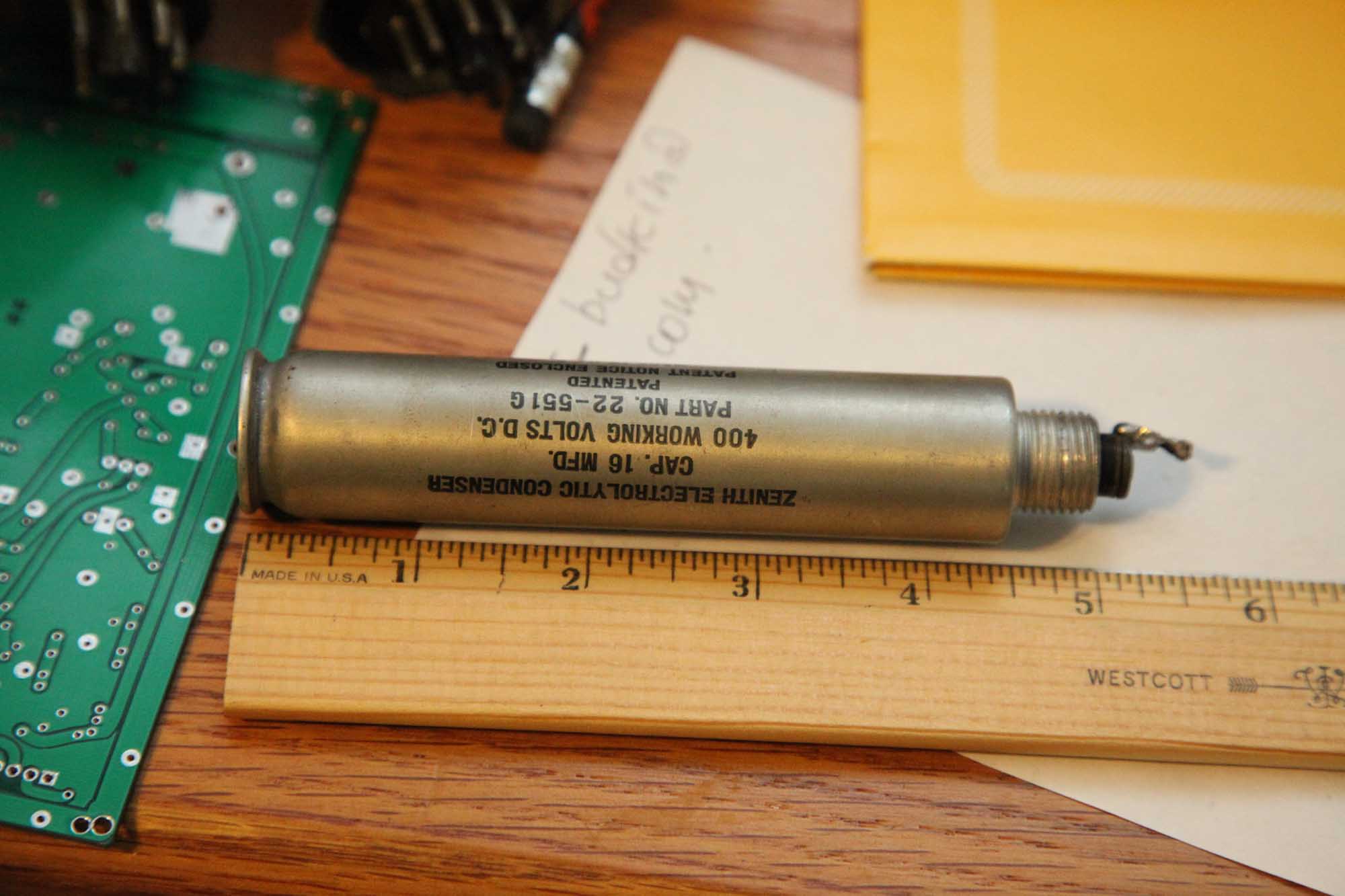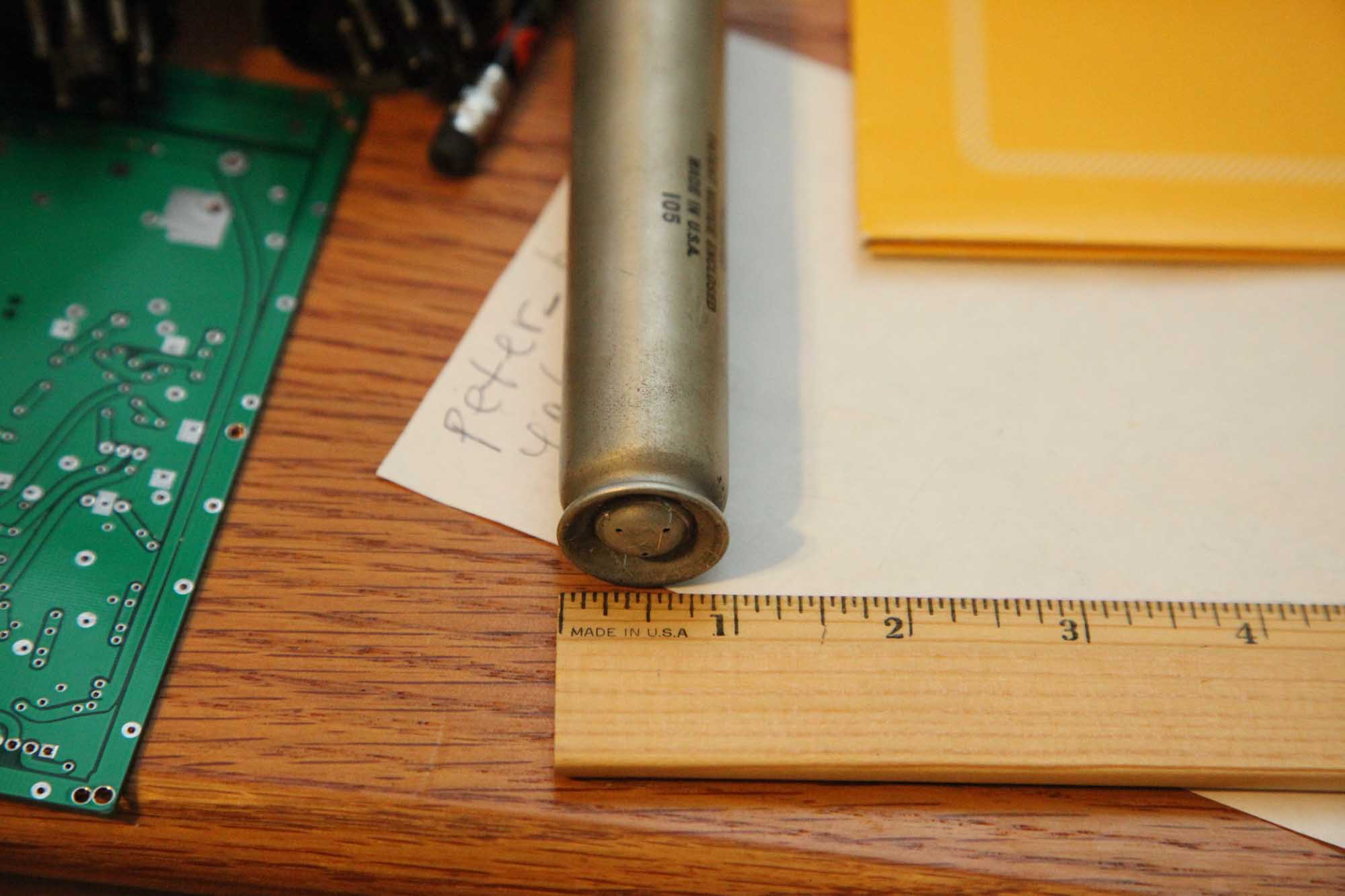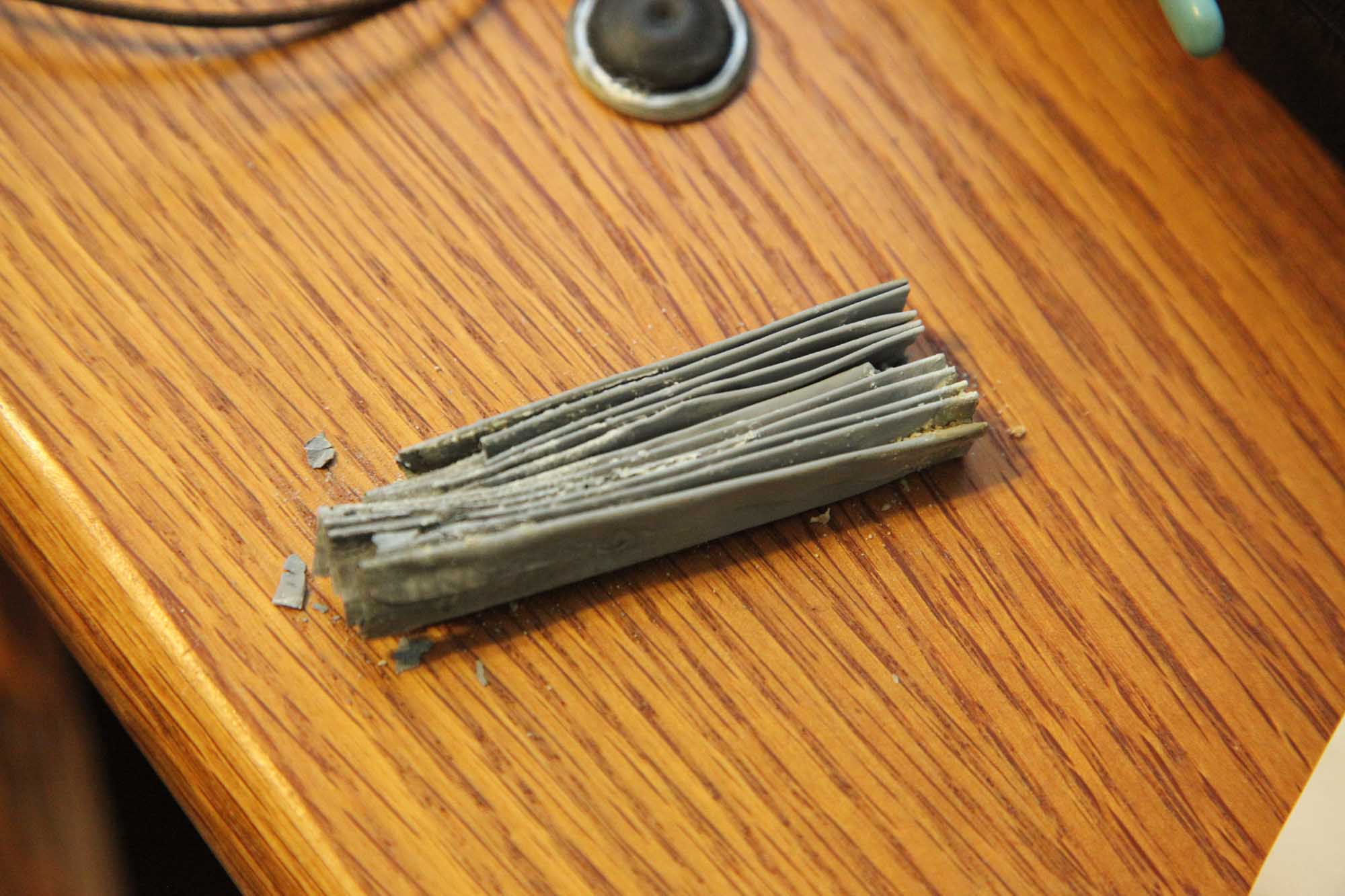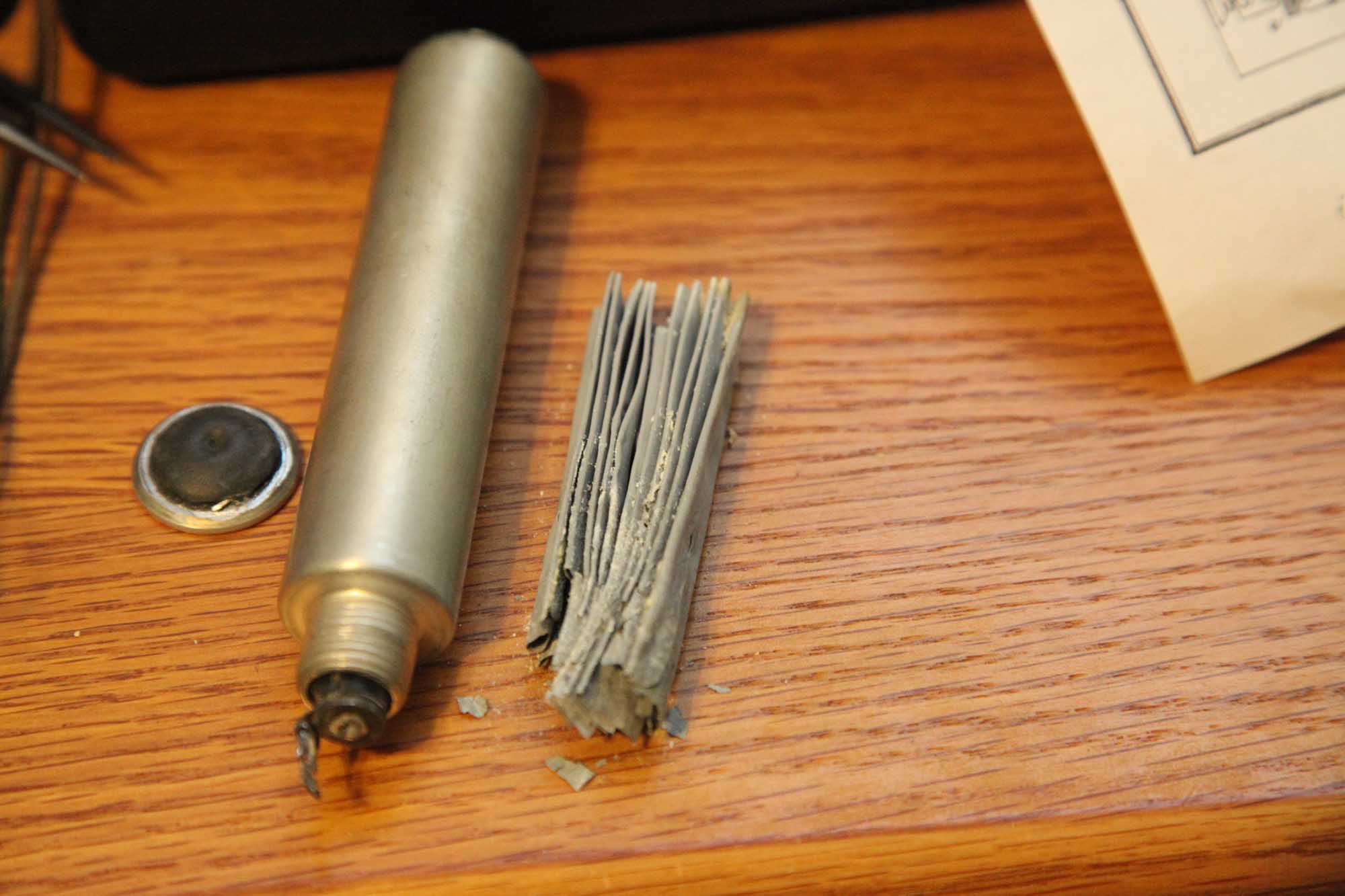Restuffing a thin long cap.
Posts: 16,582
Threads: 574
Joined: Oct 2011
City: Jackson
State, Province, Country: NJ
I have a Zenith electrolytic that is totally dried up (says 16uF 400V, measures at 1nF and is suspiciously lightweight), and that is very slim and long (under 1" diam. and 5.5" long).
I want to restuff it but not sure where best to cut it. I want it to look undamaged when it's done, but if I cut the top, I simply won't reach to the bottom. Too long and narrow. If I cut the bottom, it will look like you know what.
Anyone has experience dealing with those?
I had no problem with those that were twice as wide, but this one's a challenge.
PS. How do I connect the Negative wire to the aluminum body? (soldering won't work on aluminum.)
Posts: 2,128
Threads: 18
Joined: Oct 2008
City: Merrick, Long Island, NY
Don't seem to be problem replacing a modern 22 mf/450 VDC electrolytic in it's place. Just observe polarity. Forget about stuffing old one unless you are working in a museaum. Negative almost certainly would be "body" but trust the schematic and original connections.
Posts: 16,582
Threads: 574
Joined: Oct 2011
City: Jackson
State, Province, Country: NJ


Codefox,
Well, I know that, about polarity and such.
I really want this cap in this radio, and this is the sole purpose of this post.
Here is the cap.
Posts: 3,156
Threads: 56
Joined: Apr 2011
City: Lexington, KY
I would first try going in from the top. Using some small long needle-nose pliers and hemostats you should be able to gut the thing and slip in the new cap and fish the leads out the bottom.
If you can't do it from the top I think if you make a thin/clean cut close to the bottom it will not look that bad when reassembled. You can find or fashion a small tube to slip both the top and bottom over and glue/epoxy them together.
I would insulate both leads and run them out the bottom and then connect the applicable one to ground under the chassis at a convenient location.
Worst case scenario would be to leave the old capacitor on the chassis and mount a new one underneath. That's the way an old repair shop would have handled it, and you could even stuff the new cap into an old axial electrolytic for a period correct looking repair. Just a couple of ideas for you to think over.
John KK4ZLF
Lexington, KY
"illegitimis non carborundum"
Posts: 16,582
Threads: 574
Joined: Oct 2011
City: Jackson
State, Province, Country: NJ
John,
Thanks, yes, the axial electrolytic is not a bad idea.....provided I can get me one of the old.
As for the two insulated wires out, you probably mean something like this?

Those had insulated body and two wires and this is how i re-stuffed them; I can make this one look like it too.
Actually this is an even better idea, as the length precludes me from soldering to the center pin, but if I don't need it and am out to simply gut the cap and remove the center pin, it requires no finesse and can be done even with this length to width ratio.
Thanks, I think I know what I'll do.
It pays to discuss things.
Posts: 16,582
Threads: 574
Joined: Oct 2011
City: Jackson
State, Province, Country: NJ
I will post photos either today or tomorrow: I cut off the top cap with my Dremel and the cutting disk, right at the groove, so it will look fine.
Insides were as dry as H**l on a hot day in June.
Taking them out did not pose any problems, and there was no tar or anything. It was dry dry.
The central rod is quite high and should it be solderable I'd have no problem soldering to it, but I think it is not, and it is attached to the solder contact with a rivet of some sort.
So as I planned, I will remove it and go with two wires.
I will wait 'till I finish, but so far it is not nearly as bad as I thought it would be.
Posts: 2,128
Threads: 18
Joined: Oct 2008
City: Merrick, Long Island, NY
Posts: 16,582
Threads: 574
Joined: Oct 2011
City: Jackson
State, Province, Country: NJ
Oh Me lave los manos, sin duda. Load of dust and who knows what else.
But then any opened electrolytic commands the same handwashing: wet or dry, it is all possibly very toxic if ingested.
PS>
Here, I made some pics.



Users browsing this thread: 1 Guest(s)
|
|
Recent Posts
|
|
Philco Model 38-7: what caps & resistors do fail typically?
|
| Since you stated earlier, you have a console 38-7XX. They also had a 38-7T (table), and 38-7CS (chairside). A very nic...GarySP — 01:18 PM |
|
Part numbers to model cross
|
| That I wouldn't know, but sometimes the radio document itself shows one, same as the capacitor cans' etc pinouts.morzh — 12:46 PM |
|
Part numbers to model cross
|
| Thank you morzh, that is exactly what I was looking for. Now , is there some where that shows pinouts for Philco power ...Jim Dutridge — 11:37 AM |
|
Restoration of the Canadian General Electric A-87
|
| Thanks for your help Michael. In fact, this video is only an intermediate result. Later I had to apply another tinting l...RadioSvit — 09:01 AM |
|
Restoration of the Canadian General Electric A-87
|
| Great job on the cabinet.
PS. In the US notation, "kenotron" refers to specific type of tubes; we call re...morzh — 08:24 AM |
|
Part numbers to model cross
|
|
This document has at least some tables of models and parts used.
Example: Choke 32-7572, used in 604 radio.
Search f...morzh — 08:19 AM |
|
Restoration of the Canadian General Electric A-87
|
| I also checked all the radio tubes on my Hickok 530 tube tester. The 5Z3 kenotron turned out to be faulty, all the other...RadioSvit — 08:02 AM |
|
Restoration of the Canadian General Electric A-87
|
|
Well... While the varnish is drying up, I started repairing the chassis...
Of course I started by replacing the pa...RadioSvit — 07:12 AM |
|
Philco Model 38-7: what caps & resistors do fail typically?
|
| Hello Martin,
Welcome aboard our little community what great Model 38-7
Sincerely Richardradiorich — 12:30 AM |
|
Philco Model 38-7: what caps & resistors do fail typically?
|
| Welcome to the Phorum Martin.
I count about 9 paper caps, the 3 electrolytic caps and 2-Y2 safety caps to replace th...RodB — 09:44 PM |
|
Who's Online
|
| There are currently no members online. |

|
 
|



![[-] [-]](https://philcoradio.com/phorum/images/bootbb/collapse.png)


